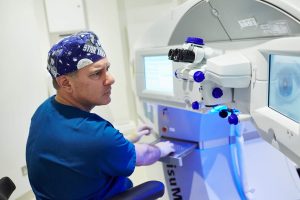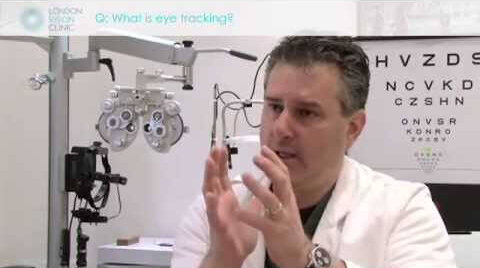Laser Eye Surgery Technology: What is Eye Tracking?

When it comes to Laser Eye Surgery, most people will have some fears or concerns before heading into the surgery room. Some of these fears may be rational, some may be irrational, but one of the most common worries we encounter when speaking with our patients is the fear of moving their eyes during the procedure.
After learning that they will be awake during the procedure (don’t worry, your eyes will be numbed!), anxiety over sneezing, yawning, or even falling off the bed understandably takes over. Thankfully, none of these things will affect your treatment, thanks to a little innovation known as eye-tracking.
What is Eye-Tracking Technology?
Eye-tracking has been around for a surprisingly long time, with the first iteration of the technology being introduced in 1908. The first eye-tracking device, a specialised contact lens invented by American psychologist Edmund Huey, was designed to track eye movement during the reading process.
Almost three decades later, Guy Thomas Buswell was the first to use light beams to track eye movement. The beams were reflected onto readers’ eyes and then recorded on film. These early iterations of eye-tracking technology had limited applications; however, the 1970s and 80s brought significant innovation. Eye trackers gradually became less intrusive and more accurate and computers were soon able to track eye movements in real time.
These developments widened the applications of eye-tracking technology. For example, companies were soon able to use eye-tracking to observe reactions to internet content. These uses were primarily used to enhance user experiences and improve the performance of web pages.
By the turn of the millennium, eye-tracking technology had been adopted by a number of industries, including market research and ophthalmology.
Laser Eye Surgery and Eye-Tracking Technology
In the world of Laser Eye Surgery, state-of-the-art eye-tracking technology involves taking a stream of photographs of the eye – between 500 and 1,000 every second! This allows us to continuously analyse the position of the eye being treated and this data is used to make adjustments to your treatment.
As our founder and expert Laser Eye Surgeon, Professor Dan Reinstein, explains in the video below, this essentially means that the treatment cannot be aimed in the wrong place.

As Professor Reinstein sums up: “Don’t worry – moving, coughing, sneezing, turning your head – none of those things will affect the end result in any way … that’s how safe this laser procedure has become.”
Your eyes will inevitably move at least a little during your Laser Eye Surgery treatment. Luckily, our eye-tracking technology will be with you every step of the way, feeding information about the movement of your eyes directly into our laser technology. The laser is then able to adjust to your eye movements. This compensation ensures that the laser delivers its beam in exactly the right place.
While there is some lag in eye-tracking, this is generally minuscule – most operate with a delay of less than one-hundredth of a second. There are various methods of Laser Eye Surgery(video infra-red, 3D, LADAR), all of which involve detecting the position of your eye. So, you can rest easy knowing that you can blink, sneeze, and move your head as much as you need to – your treatment won’t be affected!
If you’d like to learn more about our Laser Eye Surgery technology, get in touch with one of our friendly clinic coordinators – we’re always on hand to help! Alternatively, Book a Consultation to start your journey to clear vision today.


